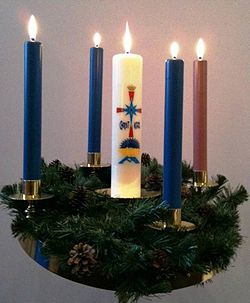| Latin | English |
|---|
1. Veni, redemptor gentium;
ostende partum Virginis;
miretur omne saeculum:
talis decet partus Deum. | Come, thou Redeemer of the earth,
and manifest thy virgin-birth:
let every age adoring fall;
such birth befits the God of all. |
2. Non ex virili semine,
Sed mystico spiramine
Verbum Dei factum caro
Fructusque ventris floruit. | Begotten of no human will,
But of the Spirit, Thou art still
The Word of God in flesh arrayed,
The promised fruit to men displayed. |
3. Alvus tumescit Virginis,
Claustra pudoris permanent,
Vexilla virtutum micant,
Versatur in templo Deus. | The virgin womb that burden gained
With virgin honor all unstained;
The banners there of virtue glow;
God in His temple dwells below. |
4. Procedens de thalamo suo,
Pudoris aula regia,
Geminae gigas substantiae,
Alacris ut currat viam. | Forth from His chamber goeth He,
That royal home of purity,
A giant in two-fold substance one,
Rejoicing now His course to run. |
5. Egressus ejus a Patre,
Regressus ejus ad Patrem:
Excursus usque ad inferos
Recursus ad sedem Dei. | From God the Father He proceeds,
To God the Father back He speeds;
His course He runs to death and hell,
Returning on God's throne to dwell. |
6. Aequalis eterno Patri,
Carnis tropaeo accingere:
Infirma nostri corporis
Virtute firmans perpeti. | O equal to the Father, Thou!
Gird on Thy fleshly mantle now;
The weakness of our mortal state
With deathless might invigorate. |
7. Praesepe jam fulget tuum,
Lumenque nox spirat novum,
Quod nulla nox interpolet,
Fideque jugi luceat. | Thy cradle here shall glitter bright
And darkness breathe a newer light,
Where endless faith shall shine serene,
And twilight never intervene. |
8. Sit, Christe, rex piissime,
tibi Patrique gloria
cum Spiritu Paraclito,
in sempiterna saecula. | All praise, eternal Son, to Thee,
whose advent sets Thy people free,
whom, with the Father, we adore,
and Holy Ghost, for evermore. |

